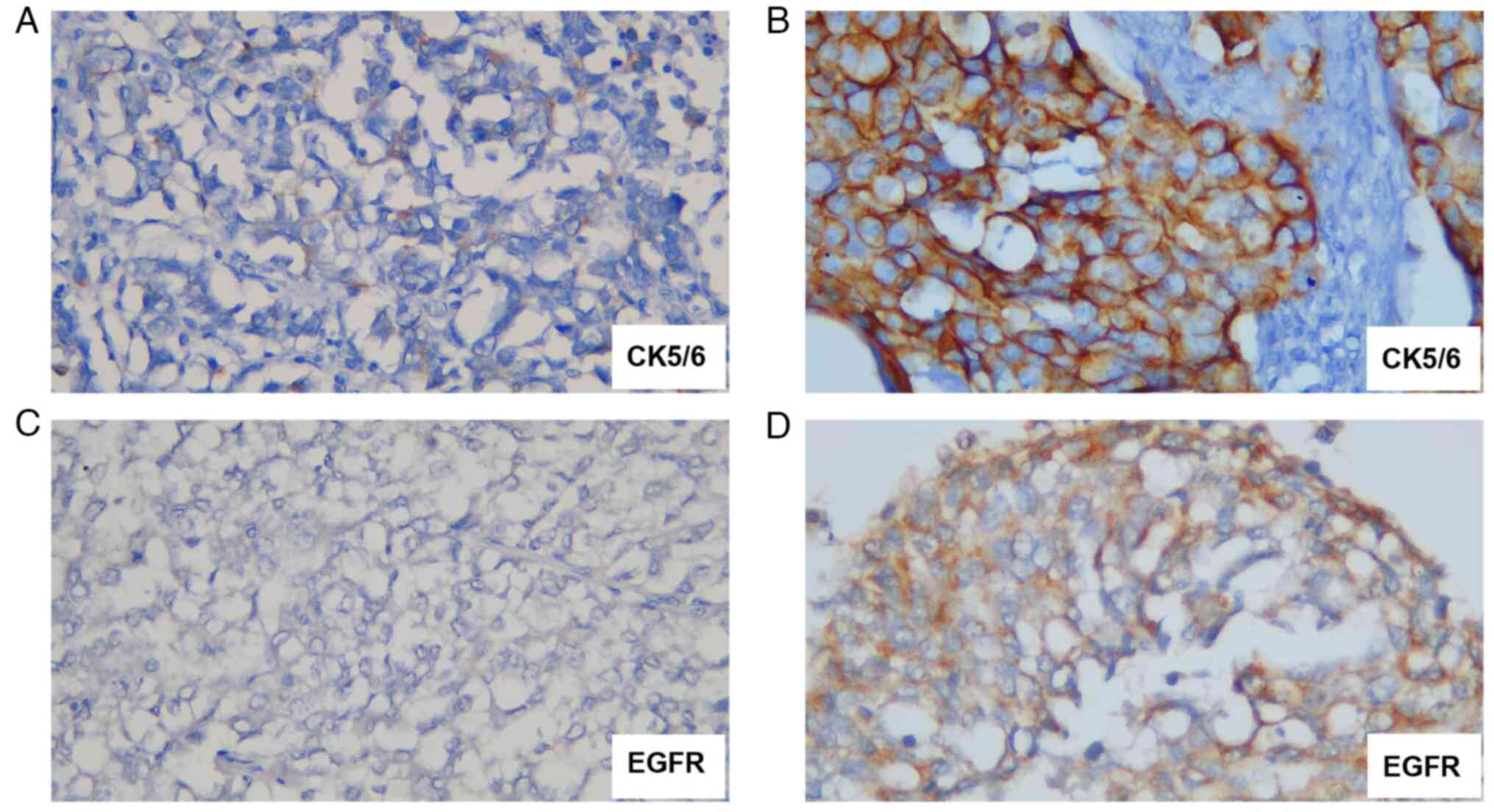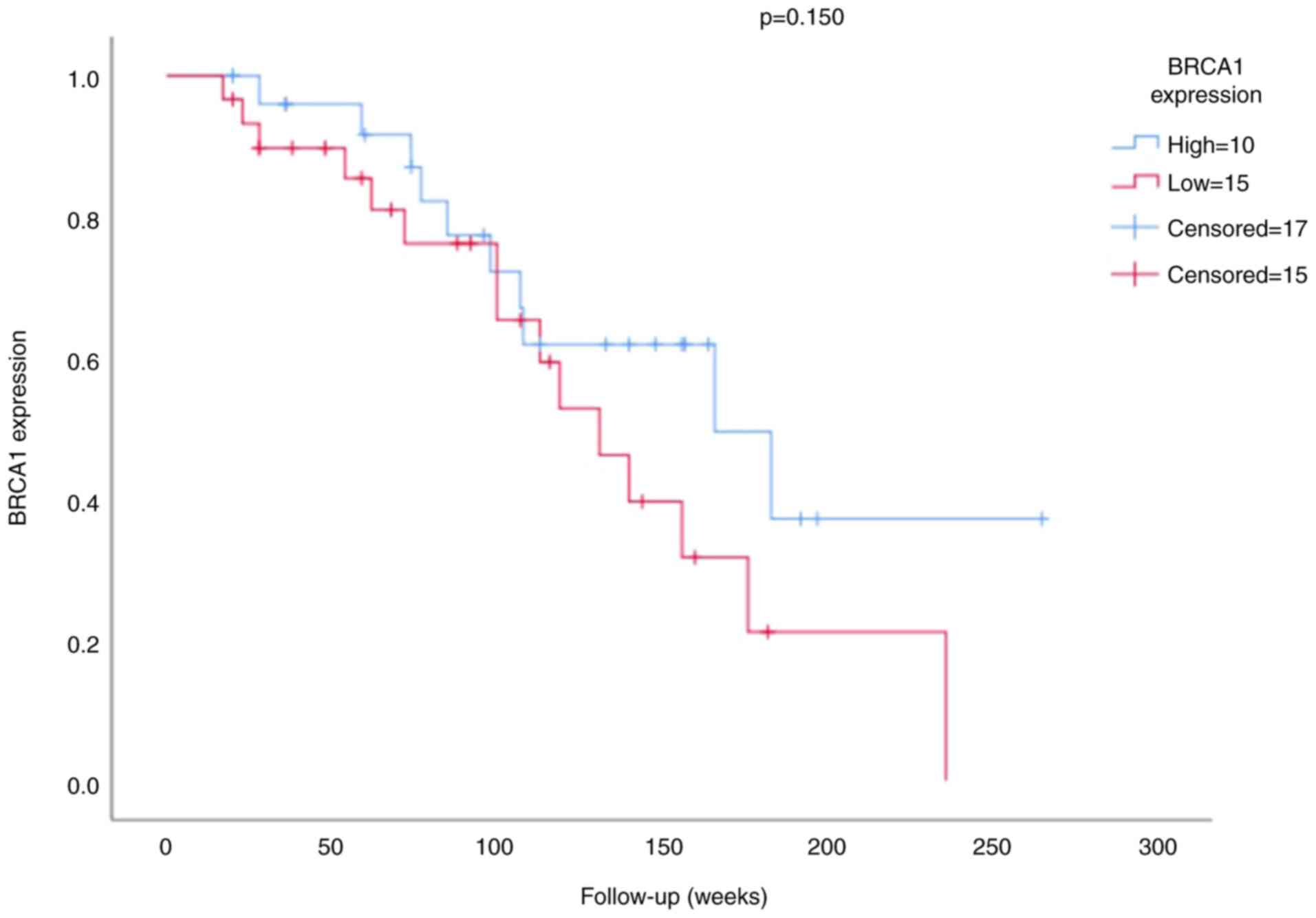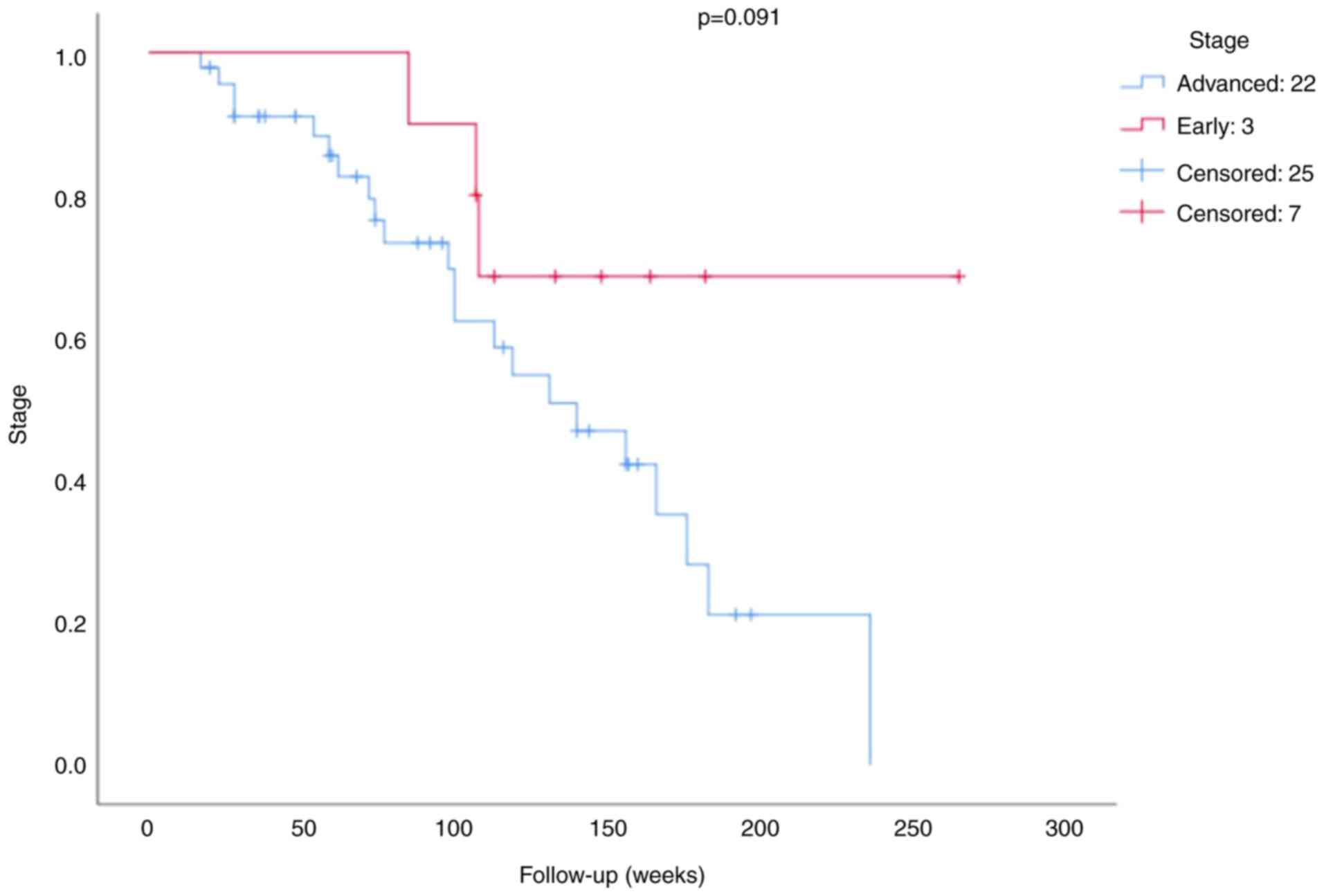|
1
|
Boyle P: Triple-negative breast cancer:
Epidemiological considerations and recommendations. Ann Oncol. 23
(Suppl 6):vi7–vi12. 2012.PubMed/NCBI View Article : Google Scholar
|
|
2
|
Yeh J, Chun J, Schwartz S, Wang A, Kern E,
Guth AA, Axelrod D, Shapiro R and Schnabel F: Clinical
characteristics in patients with triple negative breast cancer. Int
J Breast Cancer. 2017(1796145)2017.PubMed/NCBI View Article : Google Scholar
|
|
3
|
Widodo I, Dwianingsih EK, Aryandono T and
Soeripto S: Clinicopathological characteristic and prognostic
significance of Indonesian triple-negative breast cancer. Indones
Biomed J. 11:286–292. 2019.
|
|
4
|
Jang MH, Kim HJ, Kim EJ, Chung YR and Park
SY: Expression of epithelial-mesenchymal transition-related markers
in triple-negative breast cancer: ZEB1 as a potential biomarker for
poor clinical outcome. Hum Pathol. 46:1267–1274. 2015.PubMed/NCBI View Article : Google Scholar
|
|
5
|
Fedele M, Cerchia L and Chiappetta G: The
epithelial-to-mesenchymal transition in breast cancer: Focus on
basal-like carcinomas. Cancers (Basel). 9(134)2017.PubMed/NCBI View Article : Google Scholar
|
|
6
|
Han J, Lim W, You D, Jeong Y, Kim S, Lee
JE, Shin TH, Lee G and Park S: Chemoresistance in the human
triple-negative breast cancer cell line MDA-MB-231 induced by
doxorubicin gradient is associated with epigenetic alterations in
histone deacetylase. J Oncol. 2019(1345026)2019.PubMed/NCBI View Article : Google Scholar
|
|
7
|
Bou Zerdan M, Ghorayeb T, Saliba F, Allam
S, Bou Zerdan M, Yaghi M, Bilani N, Jaafar R and Nahleh Z: Triple
negative breast cancer: Updates on classification and treatment in
2021. Cancers (Basel). 14(1253)2022.PubMed/NCBI View Article : Google Scholar
|
|
8
|
Yamamoto Y, Ibusuki M, Nakano M, Kawasoe
T, Hiki R and Iwase H: Clinical significance of basal-like subtype
in triple-negative breast cancer. Breast Cancer. 16:260–267.
2009.PubMed/NCBI View Article : Google Scholar
|
|
9
|
Toft DJ and Cryns VL: Minireview:
Basal-like breast cancer: From molecular profiles to targeted
therapies. Mol Endocrinol. 25:199–211. 2011.PubMed/NCBI View Article : Google Scholar
|
|
10
|
Badowska-Kozakiewicz AM and Budzik MP:
Immunohistochemical characteristics of basal-like breast cancer.
Contemp Oncol (Pozn). 20:436–443. 2016.PubMed/NCBI View Article : Google Scholar
|
|
11
|
Bao B, Mitrea C, Wijesinghe P, Marchetti
L, Girsch E, Farr RL, Boerner JL, Mohammad R, Dyson G, Terlecky SR,
et al: Treating triple negative breast cancer cells with erlotinib
plus a select antioxidant overcomes drug resistance by targeting
cancer cell heterogeneity. Sci Rep. 7(44125)2017.PubMed/NCBI View Article : Google Scholar
|
|
12
|
Jung J, Kang E, Gwak JM, Seo AN, Park SY,
Lee AS, Baek H, Chae S, Kim EK and Kim SW: Association between
basal-like phenotype and BRCA1/2 germline mutations in Korean
breast cancer patients. Curr Oncol. 23:298–303. 2016.PubMed/NCBI View Article : Google Scholar
|
|
13
|
Maksimenko J, Irmejs A,
Nakazawa-Miklasevica M, Melbarde-Gorkusa I, Trofimovics G,
Gardovskis J and Miklasevics E: Prognostic role of BRCA1 mutation
in patients with triple-negative breast cancer. Oncol Lett.
7:278–284. 2014.PubMed/NCBI View Article : Google Scholar
|
|
14
|
Botti G, Cantile M, Collina F, Cerrone M,
Sarno S, Anniciello A and Di Bonito M: Morphological and
pathological features of basal-like breast cancer. Transl Cancer
Res. 8 (Suppl 5):S503–S509. 2019.PubMed/NCBI View Article : Google Scholar
|
|
15
|
Hussein IA, Ahmed ST, Hameedi AD, Naji RZ,
Alharbawi L, Alkhaytt M and Pity IS: Immunohistochemical expression
of BRCA1 protein, ER, PR and Her2/neu in breast cancer: A
clinicopathological study. Asian Pac J Cancer Prev. 21:1025–1029.
2020.PubMed/NCBI View Article : Google Scholar
|
|
16
|
Abulkhair O, Moghraby JS, Badri M and
Alkushi A: Clinicopathologic features and prognosis of
triple-negative breast cancer in patients 40 years of age and
younger in Saudi Arabia. Hematol Oncol Stem Cell Ther. 5:101–106.
2012.PubMed/NCBI View Article : Google Scholar
|
|
17
|
McGuire A, Brown JA, Malone C, McLaughlin
R and Kerin MJ: Effects of age on the detection and management of
breast cancer. Cancers (Basel). 7:908–929. 2015.PubMed/NCBI View Article : Google Scholar
|
|
18
|
Tzikas AK, Nemes S and Linderholm BK: A
comparison between young and old patients with triple-negative
breast cancer: Biology, survival and metastatic patterns. Breast
Cancer Res Treat. 182:643–654. 2020.PubMed/NCBI View Article : Google Scholar
|
|
19
|
Badve S, Dabbs DJ, Schnitt SJ, Baehner FL,
Decker T, Eusebi V, Fox SB, Ichihara S, Jacquemier J, Lakhani SR,
et al: Basal-like and triple-negative breast cancers: A critical
review with an emphasis on the implications for pathologists and
oncologists. Mod Pathol. 24:157–167. 2011.PubMed/NCBI View Article : Google Scholar
|
|
20
|
Leidy J, Khan A and Kandil D: Basal-like
breast cancer: Update on clinicopathologic, immunohistochemical,
and molecular features. Arch Pathol Lab Med. 138:37–43.
2014.PubMed/NCBI View Article : Google Scholar
|
|
21
|
Guterson B and Eaves CJ: Basal-like breast
cancers: From pathology to biology and back again. Stem Cell
Reports. 10:1676–1686. 2018.PubMed/NCBI View Article : Google Scholar
|
|
22
|
Kim H, Cho DY, Choi DH, Choi SY, Shin I,
Park W, Huh SJ, Han SH, Lee MH, Ahn SH, et al: Characteristics and
spectrum of BRCA1 and BRCA2 mutations in 3,922 Korean patients with
breast and ovarian cancer. Breast Cancer Res Treat. 134:1315–1326.
2012.PubMed/NCBI View Article : Google Scholar
|
|
23
|
Kwong A, Wong CHN, Suen DTK, Co M, Kurian
AW, West DW and Ford JM: Accuracy of BRCA1/2 mutation prediction
models for different ethnicities and genders: Experience in a
southern Chinese cohort. World J Surg. 36:702–713. 2012.PubMed/NCBI View Article : Google Scholar
|
|
24
|
Sugano K, Nakamura S, Ando J, Takayama S,
Kamata H, Sekiguchi I, Ubukata M, Kodama T, Arai M, Kasumi F, et
al: Cross-sectional analysis of germline BRCA1 and BRCA2 mutations
in Japanese patients suspected to have hereditary breast/ovarian
cancer. Cancer Sci. 99:1967–1976. 2008.PubMed/NCBI View Article : Google Scholar
|
|
25
|
Hedau S, Batra M, Singh UR, Bharti AC, Ray
A and Das BC: Expression of BRCA1 and BRCA2 proteins and their
correlation with clinical staging in breast cancer. J Cancer Res
Ther. 11:158–163. 2015.PubMed/NCBI View Article : Google Scholar
|
|
26
|
Shin S, Kim Y, Chul Oh S, Yu N, Lee ST,
Rak Choi J and Lee KA: Validation and optimization of the Ion
Torrent S5 XL sequencer and Oncomine workflow for BRCA1 and BRCA2
genetic testing. Oncotarget. 8:34858–34866. 2017.PubMed/NCBI View Article : Google Scholar
|
|
27
|
Mahmoud AM, Macias V, Al-Alem U, Deaton
RJ, Kadjaksy-Balla A, Gann PH and Rauscher GH: BRCA1 protein
expression and subcellular localization in primary breast cancer:
Automated digital microscopy analysis of tissue microarrays. PLoS
One. 12(e0184385)2017.PubMed/NCBI View Article : Google Scholar
|
|
28
|
Guney Eskiler G, Cecener G, Egeli U and
Tunca B: Triple negative breast cancer: New therapeutic approaches
and BRCA status. APMIS. 126:371–379. 2018.PubMed/NCBI View Article : Google Scholar
|
|
29
|
Costa REARD, Oliveira FTR, Araújo ALN and
Vieira SC: Prognostic factors in triple-negative breast cancer: A
retrospective cohort. Rev Assoc Med Bras (1992). 67:950–957.
2021.PubMed/NCBI View Article : Google Scholar
|
|
30
|
Chen B, Zhang X, Liu Y and Wang C:
Prognostic disparities in young patients based on breast cancer
subtype: A population-based study from the SEER database. Medicine
(Baltimore). 102(e33416)2023.PubMed/NCBI View Article : Google Scholar
|














